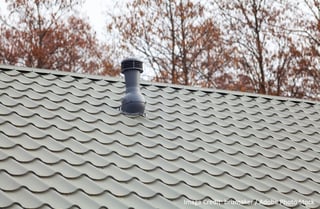Roof ventilation can be a complicated topic, but it is crucial to maintaining  optimal temperatures and saving on your energy bill. People tend to think about roof ventilation most in the summer, when beating the heat is a pressing concern – but it’s also valuable in winter.
optimal temperatures and saving on your energy bill. People tend to think about roof ventilation most in the summer, when beating the heat is a pressing concern – but it’s also valuable in winter.
During summertime, roof ventilation has a role to play in cooling the house, since hot air rises.
In the winter, the effect of ventilation isn’t as obvious, but it’s just as important. It expels water vapor that condenses in insulation, damaging it and potentially leading to mildew or mold. It also stops the formation of ice dams, which may seriously harm the roof itself.
Quick Ways to Evaluate Your Roof Ventilation
Most homes are equipped with a handful of vents in the roof to keep attic air circulating.
This is a step in the right direction, but on its own, it isn’t always enough. Still, it’s not surprising that most homeowners don’t know the signs of improper ventilation – even if you have a DIY project list a mile long, this is something that’s easy to overlook.
It’s a good idea to start with signs of ventilation issues:
Hot Air and High Attic Temperatures in the Summer
Hot attic temps in the summertime are a sign that more ventilation work might be needed on your home. If the attic seems like one of the hottest places in the house during the summer, the air is likely stagnant and needs to flow. This is a good time of year to start working on roof ventilation.
Noticeable Moisture In the Wintertime
Moisture condensation turns obvious as temperatures drop. If you notice moisture on the framing members or the insulation, it means there’s not enough air circulation while the temperature is low. Condensation is caused by the cool air mingling with warmer air from below.
Roof Patterns After a Snowstorm
Yes, your roof can even give you some clues. If you haul out a ladder and head up there shortly after a snowstorm, you should see an even coating of snow – all the way from the ridge to the eaves. If you see snow leaving the ridge clear and accumulating on the eaves, the attic is likely holding in heat.
Adding Vents to the Roof of Your Home
Most building codes specify a certain ratio of vent space to attic space – usually about a square foot of vent for every 300 square feet of floor space. However, this isn’t always adequate; it depends in large part on the position and style of your vents.
For the best results, new roof vents should be near the roof peak and close to the eaves.
This not only gives heated air an easy way to escape the structure, but supports the upward flow of cooler air that pushes warm air out. This “air recycling” is a natural part of an optimal home design.
The Longhorn Roofing team will be happy to determine the right vent locations and install new roof vents for you. To find out more, contact us today.


